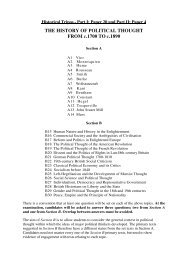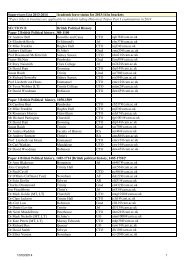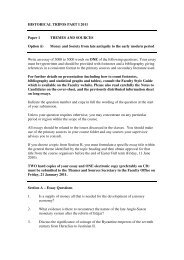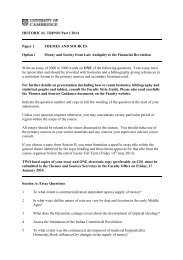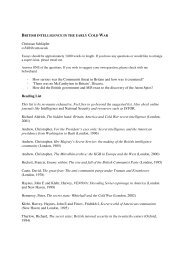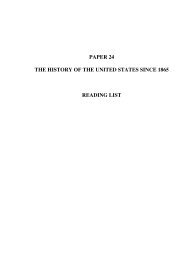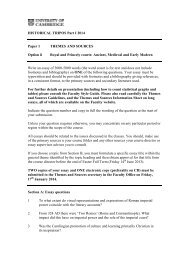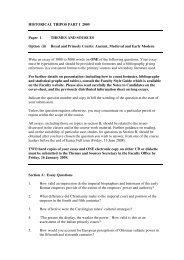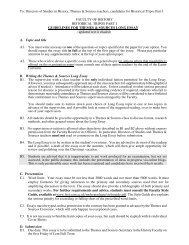Course Handbook - Faculty of History - University of Cambridge
Course Handbook - Faculty of History - University of Cambridge
Course Handbook - Faculty of History - University of Cambridge
You also want an ePaper? Increase the reach of your titles
YUMPU automatically turns print PDFs into web optimized ePapers that Google loves.
Abbreviations<br />
Note the following common abbreviations used in citations <strong>of</strong> source materials in footnotes (see also under<br />
Latin abbreviations below):<br />
ed. = editor<br />
eds. = editors<br />
edn = edition<br />
f = the following page, e.g. p. 54f<br />
ff = the following pages, e.g. pp. 54ff<br />
fo. = folio (where a manuscript is foliated rather than paginated)<br />
fos. = folios<br />
MS = manuscript<br />
MSS = manuscripts<br />
p. = page<br />
pp. = pages<br />
qu. = quoted<br />
r = recto (the front side <strong>of</strong> a foliated manuscript leaf)<br />
sig. = signature number, where there is no pagination in an early modern book<br />
trans. = translation, or translator<br />
v = verso (the reverse side <strong>of</strong> a foliated manuscript leaf)<br />
vol. = volume<br />
vols. = volumes<br />
Latin abbreviations<br />
Note that only three latinisms may be used (and none is italicized).<br />
Ibid. This is used to denote a repetition <strong>of</strong> the immediately preceding item, where only a different page (or<br />
volume) number needs to be recorded. If the preceding item is in the preceding footnote, then ibid. should<br />
only be used if the preceding footnote contains only a single reference; otherwise there is ambiguity.<br />
Idem. This is used to denote a repetition <strong>of</strong> the immediately preceding author’s name, where only a different<br />
book or article title (and page references) needs to be recorded.<br />
Passim. This is used to denote that a topic is referred to periodically throughout the source cited.<br />
Do not use ‘op. cit.’ or ‘loc. cit.’ Only use ‘cf.’ when it really does mean ‘compare’; otherwise use ‘see’.<br />
BIBLIOGRAPHY<br />
The bibliography must include all material, primary and secondary, that has been cited in the footnotes or<br />
has substantially informed the dissertation; it should not include materials consulted that have not, in the<br />
end, been used. It should normally be divided into manuscript sources, printed sources, printed secondary<br />
works, unpublished dissertations, and websites.<br />
Each item should be described as follows:<br />
a) Manuscripts<br />
1) City in which archive is to be found<br />
2) Full name <strong>of</strong> archive<br />
3) Reference according to the practice <strong>of</strong> the relevant archive<br />
b) Printed primary sources<br />
Examples:<br />
1) Source published as a whole book<br />
Stephanus, Vita sancti Wilfridi, ed. B. Colgrave (<strong>Cambridge</strong>, 1927)<br />
2) Source published as part <strong>of</strong> a book or as part <strong>of</strong> a volume <strong>of</strong> a journal (for which you should<br />
provide details <strong>of</strong> pages containing the entire source)<br />
Roger <strong>of</strong> Salerno, Chirurgia, ed. K. Sudh<strong>of</strong>f, Studien zur Geschichte der Medizin 12 (1918),<br />
148-236<br />
34





